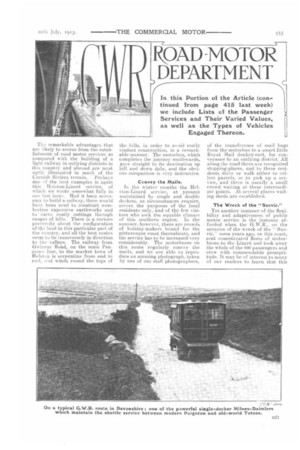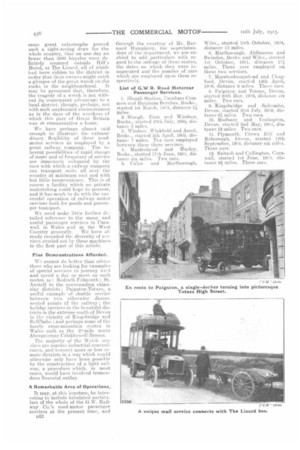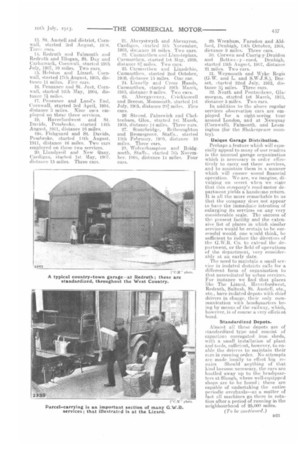FAD D -MOTOR
Page 15

Page 16

Page 17

If you've noticed an error in this article please click here to report it so we can fix it.
DEPARTMENT
In this Portion of the Article (continued from page 415 last week) we include Lists of the Passenger Services and Their Varied Values, as well as the Types of Vehicles Engaged Thereon.
The remarkable advantages that are likely to accrue from the establishment of road motor services as compared with the building of a light railway in outlying districts in this country and abroad are most aptly illustrated in much_ of the Cornish Riviera terrain. Perhaps one of the best examples is again this Helston-Lizard service, of which we wrote somewhat fully in our last issuo. Had it been necessary to build a railway, there would have been need to construct miniberless expensive earthworks and to carve costly cuttings through ranges of hills. There is a curious perversity about the configuration of the land in this particular part of the country, and all the best routes seem to lie transversely in direction to the valleys. The railway from Gwinear Road, on the main Penzance line, to the market town of Helston is serpentine from end to end, eid winds round the tops of the hills, in order to avoid costly viaduct construction, in a remarkable manner. The motorbus, which completes the journey southwards, goes straight to its destination up hill and down dale, and the obvious comparison is very instructive.
Cenvey the Mails.
In the winter months the Helston-Lizard service, at present maintained by single and double dectkeris, as circumstances require, serves the purposes of the local residents only, and of the few visitors who seek the equable climate of this southern region. In the summer, however, there are crowds of holiday-makers bound for the picturesque coast thereabouts, and the service has to be increased very considerably. The motorbuses on this route regularly convey the mails, and we are able to reproduce an amusing photograph, taken by one of our staff photographers,
of the transference of mail bags from the motorbus to a smart little Royal Mail donkey-cart, for conveyance to an outlying district. All along the road there are recognized stopping-places, and to these residents drive or walk either to collect parcels, or to pick up a service, and there is usually a small crowd waiting at these intermediate points. At several places waiting sheds are established.
The Wreck of the "Suevic."
Yet another instance of the flexibility and adaptiveness of public motor service is the instance afforded when the G.W.R., on the occasion of the wreck of the " Suevic," some years ago, on this coast, sent concentrated fleets of motorbuses to the Lizard and took away the whole of the 800 passengers and crew with commendable promptitude. It may be of interest to many of our readers to learn that this
same great catastrophe proved such a sight-seeing draw for the whole country, that on one day no fewer than 3000 bicycles were definitely counted outside Hill's Hotel, at The Lizard, all of which had been ridden to the district in order that their owners might catch a glimpse of the great wreck on the
rocks in the neighbourhood. It may be presumed that, therefore, the tragedy of a wreck is not without it's consequent advantage to a local district, though, perhaps, not with such unpleasant circumstances as in the days of the wreckers of which thiq part of Great Britain was a-n rnmunerative a home.
We have perhaps almost said enough to illustrate the extraordinary flexibility of these roadmotor services as employed by a great railway company. The inherent possibilities of rapid change of route and of frequency of service are immensely enhanced by the ease with which a railway company can transport units all over the country at minimum cost and with but little inconvenience. This is of course a facility which no private undertaking could hope to possess, and it has much to do with the successful operation of railway motor services both for goods and passel,ger transport.
We need make little further detailed reference to the many and useful passenger services in Cnrnwall, in Wales and in the West
Country generally. We have already recorded the diversity of srvices carried out by these machines in the first part of this article.
Fine Demonstrations Afforded.
We cannot do better than advise those who are looking for examples of special services to journey west and spend a day or more on such routes as : Redruth-Falmouth ; St. Austell to the surrounding chinaclay districts Paignton-Totnes, a useful example of shuttle service between two: otherwise disconnected points of the railway ; the holiday services in the beautiful districts in the extreme south of Devon in the vicinity of Kingsbridge and Salimhe; and perhaps some of the lonely cross-mountain routes in Wales such as the 20-mile route Abergav enny-Crickhow ell-Brecon ,
The majority of the Welsh services are regular industrial conveniences, and -connect more or less remote districts in a way which would otherwise only have been possible by the construction of a light railway, a procedure which, in most eases, would have involved tremendous financial outlay.
A Remarkable Area of Operations, It may, at this juncture, be interesting to include tabulated particulars of the whole of the G.W. Railway Co.'s road-motor passenger services at the present time, and n22 through the courtesy of Mr. Barnard Humphrey, the superintendent of the department, we are enabled to add particulars with regard to the mileage of these routes, the dates on which they were inaugurated and the number of cars which are employed upon them respectively.
List of G.W.R. Road Motorcar Passenger Services.
I. Slough Statien, Farnham Common and Burnham Beeches, Bucks., started 1st March, 1901, distance 51 2. Slough. Eton and Windsor, Bucks., started nth July, 1904, distance 3 miles.
3. Windsor, Winkfield and Ascot, Berks., started 5th April, 1905. distance 7 miles. TEn cars employed between these three services.
4. Maidenhead and Hurley, :Berks., started 17th June, 1911, distance six miles. Two cars.
5. Caine and Marlborough, Wilts., started loth October, 1904, distance 13 miles.
6. Marlborough, Aldbourne and Swindon, Berks. and Wilts., started 1st October, 1911, distance 17j miles. Three cars employed on these two services, 7. Moretonhampstead and Chagford, Devon, started 14th April, 1906, distance 6 miles. Three cars.
8. Paignton and Totnes, Devon, started 20th May, 1905, distance six miles, Two cars.
9. Kingsbridge and Salcombe, Devon, started 21st July, 1909, distance q miles. Two cars.
dis
tance 12 miles. Two cars.
11. Plymouth. Crown Bill and Roborough, Devon, started 12th September, 1904, distance six miles. Three cars.
12. Saltash and Callington, Cornwall, started 1st June, 1904, distance 9i miles. Three cars. 13. St. Austell and district, Cornwall, started 3rd August, f9ri8. _Threc ears.
14. Redruth and Falmouth and Redruth and Mogan, St. Day and Ca.rharrack, Cornwall, started 29th July, 1907, 10 miles. Two cars.
15. Helstour and Lizard. Cornwall, started 17th August., 1903, distance 11 miles. Five ears.
16. Penzance and St. Just, Cornwall, started 1.0th May, 1904, distance 74 miles.
17. Penzance and Land's End, Cornwall, started 3rd April, 1904, distance 3 miles. Nine cars employed on these three services.
19. Haverfordwest and St. Davids, Pembroke, started 14th August, 1911, distance 16 miles-.
19a. Fishguard and St. Davids, Pembroke, started 14th August, 1911, distance 16 miles. Two cars employed on these two services.
20. Llandyssil and New Quay, Cardigan, started 1st May, 1937, distance 15 miles. Three cars. 21. Aberystwyth and Aberayron, Cardigan, started 5th November, 1903, disance 16 miles. Two cars.
22. Carmarthen arid Llaustephan. Carmarthen, started 1st May, 1909, distance 81. miles. Two cars.
'23. Carmarthen and Llandebie, Carmarthen, started 2nd October, 1909, distance 15 miles. One car.
24. Urinelly and Cross Hands, Carmarthen, started 19th March, 1913, distance 9 miles. Two cars.
245. Abe rga yen n y, Crickliowell and Brecon, Monmouth., started 1st July, 1905_ distance 2[.[:1 miles. Five cars.
26 Stroud. Painswiek and Cheltenham, Glos., started 1st March, 1905, distance 14 miles. Three cars.
27. Stourbridge, Belhroughton and Bromsgrove, Stan's.. started 13th Febmary, 1905, distance 10 miles. Three ears.
28. Wolverhampton and Bridgnorth, Staffs., started 7th November, 1904, distance 14 miles. Four Cars. 29. Wrexham, Farndon and Aldford, Denbigh, yl:rth October, 1904, distance 9 miles. Three cars.
30, Corwen and Corrig-y-Druidon and Bettws -y coed, Denbigh, started 15th August, 1907, distance 21 miles. Two cars.
31. Weymouth and Wyke Regis (G.W. and L. and S.W.J.S.), Dorset, started 22nd July, 1912, distance 31 miles. Three cars.
12. Ncath and Pontardawe, morgan, started tat March, 1913, distance 5 miles. Two ears.
in addition to the above regular services observation cars are employed for a, sight-seeing tour around London, and at Newquay (Cornwall), Falmouth, and Leamington (for the Shakespeare country).
Unique Garage Distribution.
Perhaps a feature which will especially appeal to many of our readers is the unusual garage organization which is necessary in order effectively to carry out these services, and to maintain them in a, manner which will ensure sound financial operation. We are, we imagine, divulging no secret when we state that this cc,rupany's road-motor department yields a handsome return. It is all the more remarkable to us that the company does not appear to have the immediate intention of enlarging its services on any very considerable scale. The success of the present facility and the extensive list of places in which similar services would be certain to be successful would,, one w3uld think, be sufficient to induce the directors of the G.W.R. Co. to extend the department, or the field of operations of the department, very considerably at an early date.
The need to maintain a small service in isolated districts calls for a different form of organization to that necessitated by urban services. For instance we find that places like The Lizard, Haverfordwest, Redruth, Saltash, St.. Austell, etc., etc., have isolated depots with chief drivers in charge, their only communication with headquarters being by means of the railway, which, however, is of course a very eiiiciEnt bond.
Standardized Depots.
Almost all these depots are of standardized type and consist of capacious corrugated iron sheds, with a small installation of plant and tools, sufficient, however, to enable the drivers to maintain their cars in running order. No attempts are made locally to effect big repairs. Should anything of that kind become necessary, the cars are hustled away up to the headquarters at Slough, where well-equipped shops are to be found ; these are capable of undertaking the entire periodic overhauls—as a matter of fact all machines go there in rotation after a period of running in the neighbourhood of 25,000 miles.
(To be continued.)
































